-1
I have a Componente Button and the same is found within another componente Main. My purpose was that by clicking on this componente Button, it was alternating between other visual components inside the Main.
The Button is like a kind of Component Controller and I would like every click to show a rendered behavior on the different screen, but I’m not able to do it the way I want.
Component Main:
import React, { Component } from 'react';
import './style.css';
import Handlerbutton from './HandlerButton';
class Main extends Component{
render(){
return(
<div className="main" id="main">
<div className="start">
<Handlerbutton />
</div>
</div>
);
}
}
export default Main;
Component Button:
import React, { Component } from 'react';
import './style.css';
import StartAnimatedText from './../StartAnimation';
import Photos from './../../Photos';
class Handlerbutton extends Component {
constructor(props){
super(props);
this.state = {
nextpage: true,
page:0,
component:<StartAnimatedText />,
}
}
handleClick = () => {
const pageNumber = this.state.page;
this.setState({
page: this.state.page += 1,
component: ''
})
//console.log(pageNumber);
if(pageNumber === 0){
this.setState({
component: <Photos />
})
}
else if(pageNumber === 1){
this.setState({
component: 'Outro componente aqui...'
})
}
}
render(){
return (
<div>
{this.state.nextpage && this.state.component}
<button id="btn-start" onClick={this.handleClick}><span>Continuar</span></button>
</div>
);
}
}
export default Handlerbutton;
Rendered component:

Guy puts the code.
– novic
Ready @Virgilionovic
– Dominik
You saw a very basic example?
– novic